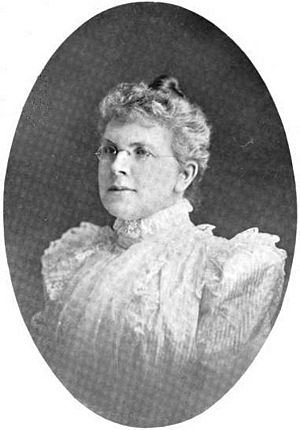Elizabeth Wells Gallup facts for kids
Elizabeth Wells Gallup (born in Paris, New York in 1848 – died in 1934) was an American teacher. She was famous for believing that Francis Bacon actually wrote the plays and poems usually credited to William Shakespeare. This idea is called the Baconian theory of Shakespearean authorship.
Contents
Early Life and Learning
Elizabeth Wells Gallup was born in 1848. She went to college at Michigan State Normal College, which is now called Eastern Michigan University. She also studied in Europe at the Sorbonne in France and the University of Marburg in Germany.
Her Work as a Teacher
Gallup taught in Michigan for about twenty years. She even became a high school principal. She used her married name, Gallup, but also kept her maiden name, Wells.
Discovering Secret Codes
Gallup became very interested in the life and writings of Francis Bacon (1561–1626). She worked with her sister, Kate Wells, on ideas from another researcher, Dr. Orville Ward Owen.
Later, Gallup became convinced that a special secret code, called the "biliteral cipher," was hidden in early printed versions of Shakespeare's works. She thought that printers used two slightly different styles of letters (called typefaces or fonts) to hide secret messages. This type of code, also known as Bacon's cipher, was something Francis Bacon himself had written about. It works by using two different letter styles in the same text to hide a message.
Gallup came up with this idea in 1895. Over the next few years, she published many books. In these books, she claimed to have found and decoded hidden messages in the works of Bacon, Shakespeare, and others. Her first book, The Biliteral Cypher of Sir Francis Bacon Discovered in his Works and Deciphered by Mrs Elizabeth Wells Gallup, came out in 1899. It was printed many times after that.
Working at Riverbank Laboratories
Later in her life, Colonel George Fabyan helped fund Gallup's work. He supported her research at his Riverbank Laboratories in Geneva, Illinois. Fabyan had also helped fund Owen's earlier work. He even hired a team of researchers to work on Gallup's theory. One of these researchers was Elizebeth Smith, who later became Elizebeth Friedman.
While at Riverbank, Gallup published many books. These books claimed to reveal hidden messages in the writings of Bacon and other authors. Her decoded messages "discovered" some amazing things. For example, she claimed that Bacon was actually the son of Queen Elizabeth I and the true heir to the throne. She also said he wrote the works of other famous writers like Christopher Marlowe, George Peele, and Robert Burton. Gallup even published a play called The Tragedy of Anne Boleyn, which she said was hidden in code within Bacon/Shakespeare's works.
Why Her Theories Were Not Accepted
None of the people who helped Gallup with her decoding at Riverbank could ever get the same results she did.
Later, in 1957, Elizebeth Smith Friedman and her husband, William F. Friedman, published a book called The Shakespearean Ciphers Examined. This book carefully looked at different theories about Bacon and Shakespeare, including Gallup's. They concluded that there was no real proof that the biliteral cipher was used in Shakespeare's works.
The Friedmans showed that the different letter styles used in Shakespeare's printed works were just normal printing practices of that time. Printers often used many different fonts in a seemingly random way. Experts also looked at the letter fonts in Shakespeare's plays. They found that, with very few exceptions, it was impossible to clearly separate them into two groups, which is what Bacon's biliteral cipher needs.
The Friedmans pointed out that Gallup, when trying to use Bacon's cipher, could pick and choose letters from the variable fonts. This gave her a lot of freedom to find "what it was she was determined to find." In other words, she found what she wanted to find, not necessarily what was truly there.


